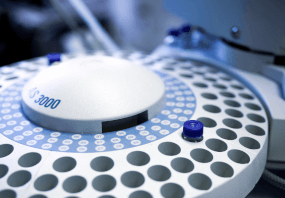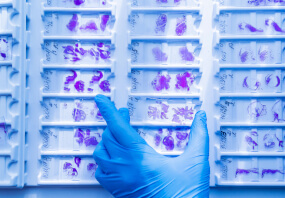General description
Anti-α-Tubulin antibody, Mouse monoclonal (mouse IgG1 isotype) is derived from the hybridoma AA13 produced by the fusion of mouse myeloma cells and splenocytes from BALB/c mice immunized with rat brain tubulin.
Tubulin α 1a (TUBA1A) is a member of α-tubulin gene family. It is encoded by the gene mapped to human chromosome 12q13.12. Tubulin α 1a is a vital structural subunit of microtubules that are temporarily expressed in almost all post-mitotic neurons during neuronal development.
The encoded protein structure contains core of two β-sheets enclosed by α-helices. TUBA1A is characterized with an amino-terminal domain with the guanine nucleotide-binding region, an intermediate domain associated with interprotofilament lateral contacts and the modulation of tubulin curvature, and a carboxy-terminal domain that contains region involved in interacting with microtubule-associated proteins (MAPs) and molecular motors, such as kinesins and dynein.
Immunogen
rat brain tubulin.
Application
Anti-α-Tubulin antibody, Mouse monoclonal has been used in western blotting.
The antibody has been used in various immunochemical techniques including immunoprecipitation, immunocytochemistry, and immunohistochemistry.
Biochem/physiol Actions
Gene mutation of tubulin α-1A (TUBA1A) is observed in perisylvian asymmetrical polymicrogyria, polymicrogyria-like cortical dysplasia, and microlissencephaly in foetal cases. Alteration in the expression of the gene impairs neural migration and causes lissencephaly (LIS).
Tubulin is the major building block of microtubules, which is a structural and mobile element in mitosis, intracellular transport, flagellar movement and the cytoskeleton. Monoclonal antibodies recognizing α-tubulin, together with monoclonal antibodies to other tubulin types (α-tubulin isotypes I, II, and III, tyrosine tubulin and acetylated- α -tubulin) provide a specific and useful tool in studying the intracellular distribution of tubulin, and the static and dynamic aspects of the cytoskeleton. In addition, the various tubulin forms have been implicated in cancerous processes and are thus suggested as potential targets for cancer therapy.
Target description
Tubulin is a cylindrical, filamentous structure is present inalmost all eukaryotic cells.
Physical form
Solution in 0.01 M phosphate buffered saline, pH 7.4, containing 15 mM sodium azide.
Disclaimer
Unless otherwise stated in our catalog or other company documentation accompanying the product(s), our products are intended for research use only and are not to be used for any other purpose, which includes but is not limited to, unauthorized commercial uses, in vitro diagnostic uses, ex vivo or in vivo therapeutic uses or any type of consumption or application to humans or animals.
Shipping Information:
Dry Ice Surcharge & Ice Pack Shipments: $40
More Information: https://cenmed.com/shipping-returns
- UPC:
- 41116133
- Condition:
- New
- Availability:
- 3-5 Days
- Weight:
- 1.00 Ounces
- HazmatClass:
- No
- MPN:
- T8203-25UL
- Temperature Control Device:
- Yes












